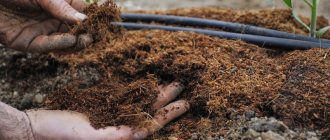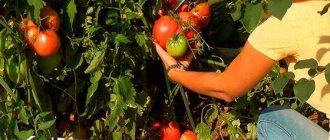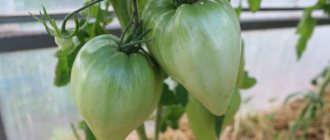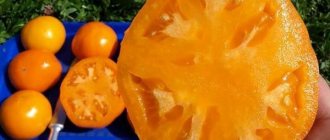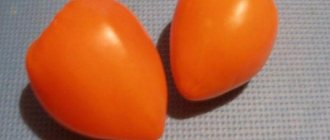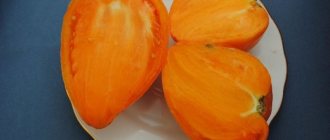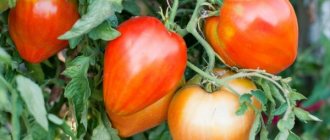Loading…
Loading…
When growing tomatoes, every farmer strives to get a good harvest as soon as possible. Many people choose the Golden Heart tomato for planting, since up to 3-4 kg of massive orange fruits can be collected from one bush. In addition, this variety is ultra-early ripening and does not require special “privileges” in care. Still, it's worth learning a little more about him.
Description and characteristics of the variety
Included in the line of productive groups, it is distinguished by its endurance to hot and cool weather. The foliage and bushiness are moderately expressed.
Tomato Golden Heart “Sedek” forms 5-7 tomatoes on fruiting clusters. In total, up to 8 clusters of fruits are formed on 1 plant.
The height of tomato stems reaches 80-90 cm in open beds. When grown in protected conditions 1.2 m.
Characteristics of tomato fruits Golden Heart “Siberian Garden”:
- average weight 150 g, large specimens weigh up to 300 g;
- elongated, longitudinal shape;
- moderate ribbing at the stalk;
- 4 seed chambers, few seeds;
- the pulp contains a lot of meat, sugar;
- high level of carotene;
- the taste is sweetish with a gentle sourness.
Tomato Golden Heart “Aelita” is a determinate, medium-growing variety.
Origin of tomato
The tomato is a successful result of Russian selection. Created in 1999 by leading agrobiotechnician Panchev. Registered in 2001 in the State Register.
Growing
The versatility of the variety allows you to grow fruits in open soil, a greenhouse and even on a balcony. For cultivation, good quality soil is required; for this it is recommended to mix garden soil in equal proportions with compost, turf, peat or river sand. The store-bought mixture is not suitable for this type of tomato.
Sowing of seeds is carried out at the end of March. It is recommended to pour boiling water over the soil, pickle the seeds in a solution of hydrogen peroxide, then soak in a stimulant. The presented tomato variety is early ripening, so it practically does not get sick, which makes it possible not to treat the seeds before planting.
The seeds are sown to a depth of 2 cm, watered, buried and covered with film. The dive is performed in the 2-leaf phase. Planting in a permanent place takes place 60–70 days after the frost has passed. Planting pattern: 65–70x45 cm.
It is better to plant in areas where carrots, cabbage, and legumes previously grew. It is not advisable to plant in places where there were tomatoes, eggplants, peppers and potatoes. The place of sowing and cultivation must be changed annually. Due to this, the soil is depleted more slowly. Bushes remaining after harvesting must be completely removed.
See also
Description of the Potato Raspberry tomato and agricultural cultivation techniques
Read
Features of cultivation and storage
Seedlings are planted in stationary beds at the age of 50-60 days.
The Golden Heart variety is intended for planting in open areas, as well as in greenhouses and greenhouses. It is grown traditionally - through seedlings.
The beds are chosen in well-lit places; the best predecessors for tomatoes are green manure crops, beans, carrots, and beets. Nightshades are an extremely undesirable option.
3-4 bushes are placed per 1 m2, the optimal distance is 50-60 cm. The depth of the holes is 30 cm.
The following is applied to the holes as fertilizer:
- 1 handful of compost;
- 1 handful of rotted humus;
- 10 g superphosphate;
- 1 tbsp. wood ash.
To achieve maximum yields, follow simple rules:
- water moderately 2 times a week, water norm is 7 liters;
- feed in the form of bioinfusions, 1:10 diluted mullein or poultry droppings;
- form into 2-3 shoots;
- stepchildren 1 time every 10-12 days;
- mulch with straw or hay, a layer of at least 8 cm.
Advantages and disadvantages
Among the main advantages it is worth noting:
- high taste qualities of fruits;
- attractive appearance;
- abundance of useful microelements in fruits;
- the versatility of tomatoes, they can be eaten fresh, canned, and widely used in cooking;
- excellent yield;
- resistance to late blight, fusarium, verticillium, alternaria;
- cold tolerance, drought resistance;
- The compact bush saves space in the garden bed.
The yield of other varieties is presented below:
| Variety name | Productivity |
| Golden heart | 7 kg per square meter |
| Apparently invisible | 12-15 kg per square meter |
| American ribbed | 5.5 kg per bush |
| Apples in the snow | 2.5 kg per bush |
| King of the Market | 10-12 kg per square meter |
| Early love | 2 kg per bush |
| The president | 7-9 kg per square meter |
| Samara | 11-13 kg per square meter |
| Nastenka | 10-12 kg per square meter |
| Baron | 6-8 kg per bush |
| Yablonka Russia | 3-5 kg per bush |
Among the difficulties of the Golden Heart variety are the need for pinching and bush formation and the high demands of tomatoes on soil nutrition and watering schedule. The more you take care of the bush, the higher the yield and the larger the fruits.
The nuances of growing in open ground and greenhouses
Growing Golden Heart in open ground is complicated by the fact that the plant is not protected from the vagaries of the weather. Low temperatures or humidity create a favorable environment for the development of fungi. The most dangerous enemy of tomatoes is late blight, a type of fungal infection.
The fungus appears as spots on the leaves. To prevent it, you should loosen and water the soil in time, and also, for prevention, spray the beds with garlic solution.
If you plant the Golden Heart in a greenhouse, you should pay attention to some features:
- Do not forget to periodically ventilate the room.
- Do not allow the greenhouse to become hot and humid at the same time.
- Regularly inspect plants for darkening and unusual coloring of leaves and fruits.
- If any illness is detected, take immediate action.
Features of care
When growing in a greenhouse, the soil is first dug up, watered with boiling water, and a spoonful of ash and superphosphate is placed in the holes. After planting, the seedlings are tied up; stable watering with warm water is important. The first stepsons need to be removed after they reach 8–10 cm. It is best to do this in the morning or evening, so the wounds on the bushes will heal faster. Greenhouse tomatoes need timely ventilation, removal of weeds, and tearing off the lower leaves of tomatoes.
Watering should be done with warm, settled water. Afterwards, be sure to loosen the soil. During the season you will need to fertilize 3-4 times using complex mineral fertilizers. You can also do preventive spraying using a soap solution or manganese solution.
During the period of intensive growth, plants are watered frequently and at the root. Some gardeners cut off the neck of the bottle and place it at the bottom so that the tomato stems use water as needed. In extreme heat, you should not water tomatoes, as this can lead to the development of late blight and deterioration of the condition of the bush.
The bush is formed into 2 stems, the leaves are thinned out. The distance between bushes should be at least 70 cm.
How to grow seedlings
For a rich harvest, experienced gardeners recommend starting the Golden Heart planting procedure with seedlings. To do this, you need to prepare the soil, container and seeds.
Seed preparation
Before planting, the seeds must be placed in a small bag and placed in a glass with a solution of potassium permanganate for 20 minutes. Then you should rinse them with water. Washing will ensure the seed material germinates more easily and protects it from viruses and fungi.
The next stage of preparation is soaking in a solution based on wood ash. Ash is an excellent fertilizer for both tomato seedlings and ready-made beds .
You should similarly immerse the bag of seeds in the solution for 12 hours, and then in clean water for 24 hours. This simple operation makes the seeds resistant to bad weather and develops immunity.
Container and soil
The container can be purchased at the store. For example, these will be peat pots or special plastic cassettes for seedlings. However, you can save money and place the seeds in ordinary plastic jars or buckets. Sometimes gardeners use containers for mayonnaise or other products. The main thing is that the container is clean and dry.
As for the soil, there are two ways:
- Make your own soil for seedlings. The standard set of ingredients is clean soil from the garden, peat, ash, sand or sawdust. Peat absorbs excess moisture and stores it in its pores, and sand or sawdust serves as a loosening agent for the soil. It is best to use river sand without clay impurities. Also, the use of these components improves drainage.
- Buy ready-made soil at the store. It already contains the necessary set of nutrients. The structure of such soil is always loose, so that young bushes have access to fresh air without problems. The purchased land has already been processed and does not contain fungal spores and dangerous microbes.
Important ! If you prepared the soil for seedlings yourself, do not forget to disinfect it with a solution of hydrogen peroxide.
Sowing
You should pour soil into the container and make small holes. A seed is placed in each of them, sprinkled with earth on top and watered abundantly. It is best to cover the seedlings with glass or cling film. This way the plant will sprout its first shoots faster.
Growing and care
The first shoots appear within a week from the moment of planting.
It is important not to miss this moment and remove the film in time. Move the container to the lightest windowsill in the house. Maintain a sufficient level of moisture and periodically spray the sprouts with a spray bottle. Remember to ventilate, but protect the seedlings from drafts and air conditioning.
It is better to water the sprouts with warm, settled water. 10 days after the first leaves appear, it is recommended to apply the first fertilizing. For example, fertilize with a solution of bird droppings.
2 weeks before transplanting into the ground, hardening is carried out - the temperature in the room is reduced by several degrees, opening the windows and balcony doors.
Harvesting and application
Since the ripening period is long, vegetables are harvested all summer. This allows you to enjoy the juicy taste of the Golden Heart before the beginning of autumn. Some vegetables are consumed fresh, while others are prepared for canning. Due to their small size, tomatoes are great for whole pickling.
In addition, the variety is suitable for preparing various dishes. For example, stuffed tomatoes or sun-dried tomatoes, vegetable stew or tomato soup. A high content of vitamins will make food not only tasty, but also healthy. Orange tomatoes will also decorate any holiday table.
Important ! The variety tolerates transportation well over long distances and has a high shelf life. In addition, Golden Heart is grown not only for personal consumption, but also for sale.
Characteristics of tomato Golden Heart
The Golden Heart tomato has an original shape and bright color. In open ground it grows as a small bush. Determinate tomatoes are planted with caution. It is recommended to remove stepsons only up to the first flower cluster. And then partially form the rest of the bush, but after the development of additional stems. When all stepsons are removed at once, the yield decreases.
Bushes can be grown without a garter, but in this case the leaves of neighboring plants close together, which complicates care and creates a favorable environment for the appearance of diseases and pests.
Tomato yield Golden Heart and fruiting
The yield of Golden Heart tomatoes is high. The crop has good fruit set and productivity throughout the entire growing season. The first tomatoes ripen 85 days after sowing. The yield in open ground is about 5 kg. The number of fruits is affected by care and climatic conditions in the growing region.
Area of application of fruits
The fruits have a universal purpose. Suitable for both fresh consumption and various processing, whole-fruit harvesting. They are used to make dietary juices, which are also used in children's diets. The high dry matter content makes it possible to obtain delicious sun-dried tomatoes. Tomatoes are also suitable for freezing in pieces.
Resistance to diseases and pests
The description of the culture indicates its resistance to major diseases. Thanks to early ripening, plants can avoid the period when mass infection of nightshade plants with late blight begins. But preventive treatments with biofungicides are also recommended for him.
Methods of eating fruits
The main characteristic of this tomato variety is the versatility of its taste. Tomatoes can be grown for the following purposes:
- for home canning: pickling, pickling, cooking in own juice, preparing salads for the winter;
- for preparing fresh salads;
- for creating sauces;
- to improve the taste of side dishes;
- for seasoning soups;
- for squeezing thick, vitamin-rich juice.
Growing a Golden Heart tomato will not be difficult if you follow the recommendations described above for sowing and planting planting material. Don’t forget about providing special care to seedlings and formed bushes. Reviews say that if all these conditions are met, the summer resident will be able to enjoy vegetables grown with his own hands, while maintaining their freshness and usefulness until the winter.
Fruit
The variety is universal in use. Sweet tomatoes are great for vegetable appetizers and salads. The juicy but not watery pulp produces wonderful juices with a rich taste . “Golden Heart” has good product characteristics. The fruits weigh 120–200 g. They are:
- bright orange;
- heart-shaped;
- covered with dense but thin skin;
- able to ripen at home.
They do not crack in garden beds or when preserved, but they do not tolerate transportation very well.
